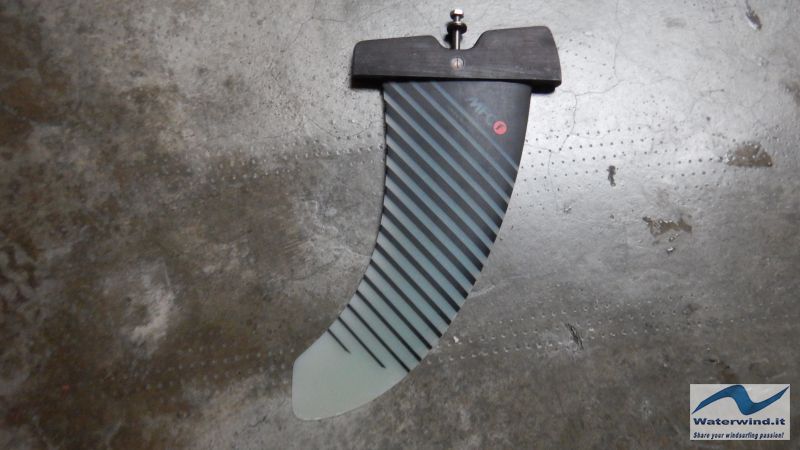BOARD PREPARING
Now let's turn our attention to the board. Here there is much less to do: in the boards that are provided with it, check that there is the centerboard (daggerboard), and insert it and fold it in a fully retracted position.
Then, the rear fin must be mounted in its box, according to the box type of our board (in the photo below, the handy powerbox-type, which passes the board thickness). Probably, if you are reading this article, you will not yet be at the level of using multifins boards of low volume, but know that the boards can also have two, three, or four fins, and that today some boards have up to 5 boxes, in order to be set as trifin or quad (4 fins). Furthermore, there are different types of boxes: in addition to the aforementioned power-box, there are the Tuttle box (with two screws), Us-Box, Slot box, and also some specific boxes used only by some brands.
Then, screw, more or less at half way, in the special track, called mast track, the mast foot, which nowadays is usually integrated with a flexible joint. Different positions of the mast foot in the track (more forward or more rearward) are reserved for already more experienced riders who try to vary the behavior of the board according to the conditions (in a nutshell, forward foot for light wind and to facilitate the planing start; rearward foot, for strong wind and to have a more reactive board).
The straps (or foot straps). The three (in wave/freewave/freestyle boards), or, normally, four straps (freeride/slalom/race boards) are only used when you are planing, so there are many who even recommend unscrewing them and putting them aside, for the first time.
However, if you would like to prepare them for their use, as a beginner you will have to fix them in a fully forward position (towards the bow), and towards the center of the board, and check that the feet enter them in such a way that the fingers come out completely on the other side, avoiding that the strap reaches the ankle (risk of getting hurt). Also in this case, the fine adjustment of the width of the straps depends on personal preferences, and on the discipline (narrower in freeride / slalom, to have more control of the windward board rail with the heels, when gliding; wider in waveriding, to help you bearing away in the bottom turn, and more generally in frequent changes of direction).
Practical advice: if our beginner board - unfortunately only a few nowadays - has a ring or a hole in the bow, it will be useful to connect a small rope loop to it, to which, in case of recovery by rescue boats, it will be easy to connect even larger ropes. Moreover, someone (in the life jacket, harness, or somewhere else, has the good habit of carrying a 4 mm rope with him, to replace the downhaul or the outhaul line, or that of the boom handle line in case of breakage in the water).
VERY IMPORTANT: the vast majority of modern boards for medium and advanced riders, but now also many beginner boards, have a screw positioned in front or behind the mast track. This is the relief valve of the board you need, in sandwich boards, to prevent internal pressure changes, primarily due to the board overheating caused by the summer sun, but also to other factors (transport by plane or in the mountains, for example), may cause serious damage to the board. Therefore, it is essential to remember to close it as the last thing of the preparation operations, tightening well but without exaggerating, so that the small rubber gasket that is under the head of the screw makes a seal, and prevents the entry of any trace of water inside. Then, at the end of the day, but also every time we leave the board under the summer sun for more than a few time, we must remember to open it by slightly unscrewing it (just a few turns). In reality, you can also avoid unscrewing the valve, in order not to risk (as happened to many) to enter the water with the valve open, causing water to enter inside the board. This is possible, if the spots you frequent are spots where it is not excessively hot, or, if you are always careful not to leave the board in the sun for more than a few minutes (10-20 minutes), moving it promptly to the shade when you are not using it. If you happen to enter the water with the valve open, immediately return to shore, and leave the board in the sun for a few days (depending on how much water may have entered), with the valve completely unscrewed (and removed).




